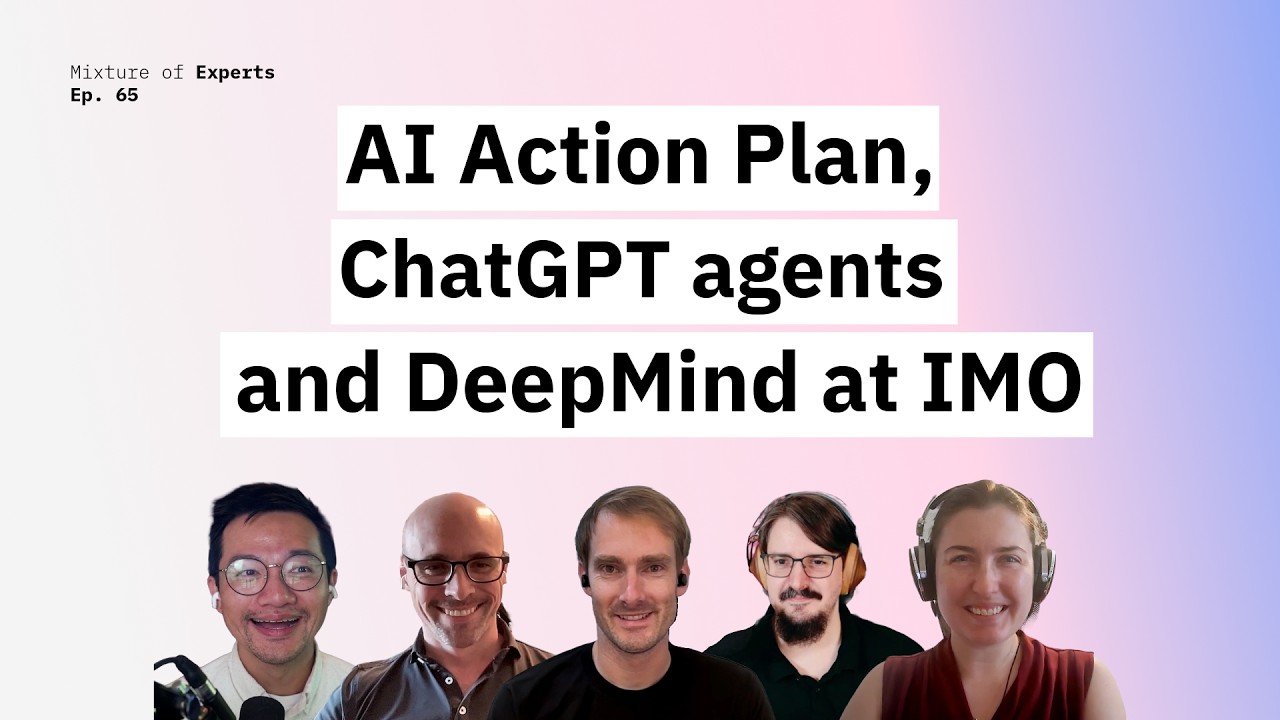The video discusses recent AI advancements showcased at the International Math Olympiad, highlighting how systems like DeepMind and OpenAI combine large language models with specialized tools to achieve expert-level mathematical reasoning, alongside the emergence of ChatGPT agents enabling semi-autonomous workflows and the development of middleware like MCP Gateway to manage AI tool interactions securely. It also covers the White House AI Action Plan, emphasizing a national strategy to accelerate AI innovation, infrastructure, and international leadership, with strong support for open-source AI and forthcoming legislative efforts.
The video begins with a discussion on the International Math Olympiad (IMO), highlighting recent claims by DeepMind and OpenAI that their AI systems have achieved gold-standard performance comparable to the top 8-10% of high school mathematicians. The panelists debate whether this achievement represents a landmark “Lee Sedol moment” akin to AlphaGo’s victory in Go. While acknowledging the technical impressiveness, they suggest that the practical real-world impact may be incremental rather than revolutionary in the near term. The conversation emphasizes how these AI systems combine large language models with specialized tools and parallel processing to solve complex mathematical problems within realistic time constraints, marking a significant advance in AI reasoning capabilities.
The panelists then explore the evolving nature of AI problem-solving techniques, moving beyond simple prompt-based approaches to more sophisticated, tool-augmented, and massively parallel methods. This shift allows AI to verify and refine its outputs more reliably, albeit at higher computational costs. They also discuss the challenges of evaluating AI performance on expert-level tasks like the IMO, where the small population of human experts makes traditional statistical benchmarking difficult. Instead, expert human judges play a crucial role in assessing AI outputs, highlighting the need for trust and collaboration between humans and AI as capabilities advance.
Next, the conversation shifts to OpenAI’s recent release of ChatGPT agents, which enable asynchronous, agentic workflows where users can delegate tasks to AI agents that operate semi-autonomously. While the underlying technology builds on existing capabilities like code execution and web browsing, the new user interface represents a significant leap in user experience by allowing users to “walk away” while agents complete tasks. However, concerns remain about security, trust, and the extent of autonomous actions agents can take without user intervention, especially in enterprise contexts. The panelists agree that consumer adoption and iterative improvements will likely precede broader enterprise deployment.
The discussion then turns to Mihi Crevetti’s MCP Gateway project, an open-source middleware solution designed to manage the complexity and security challenges of AI agents interacting with diverse tools and protocols. MCP (Model Context Protocol) aims to standardize how AI agents connect to external tools, but the ecosystem is currently fragmented with multiple versions and incomplete implementations. The MCP Gateway provides a centralized point for authentication, authorization, monitoring, and protocol translation, helping developers manage the “wild west” of agent-tool interactions. This middleware approach is seen as essential for scaling, securing, and maintaining AI agent systems as they become more widespread.
Finally, the video features an interview with Ryan Hagaman, the global AI policy issue lead, discussing the newly released White House AI Action Plan. This national strategy outlines over 130 recommended actions across three pillars: accelerating AI innovation, building American AI infrastructure, and leading international AI diplomacy and security. A notable highlight is the administration’s strong endorsement of open-source AI development, signaling a shift from previous uncertainty to positive support. The plan also includes executive orders to streamline energy and data center buildouts critical for AI growth. Ryan emphasizes that this plan is just the starting point, with significant legislative and regulatory work ahead to implement these policies effectively.
